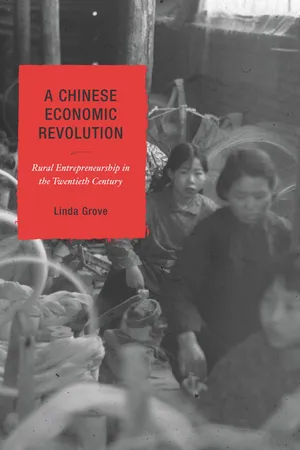
eBook - ePub
A Chinese Economic Revolution
Rural Entrepreneurship in the Twentieth Century
- English
- ePUB (mobile friendly)
- Available on iOS & Android
eBook - ePub
About this book
This powerful and meticulously researched study explores the role of rural industry and entrepreneurship in the Chinese economic miracle. Linda Grove considers especially the development of the Gaoyang industrial district, China's best-known rural industrial district of the pre–World War II period. By focusing on one weaving district in North China, she is able to explore in detail the ways in which small industrial firms have accumulated capital, organized their firms, developed nationwide marketing networks, and promoted brands over the last century. Cutting across the conventional divide between studies of "history" and "contemporary economy" and between pre- and post-1949 China, the author persuasively shows the links between traditional Chinese business practices and contemporary entrepreneurial success.
The first book in English to explore the world of small-scale business firms in China, it introduces the activities of individual entrepreneurs and firms and examines the structure of industrial organization that has supported the rapid growth of individual firms. Based on several decades of archival research, surveys, and fieldwork, A Chinese Economic Revolution provides an in-depth exploration of Chinese rural industry. Framed by the author's extensive familiarity with rural industrial development in Japan, India, and Europe, the book also offers important comparative perspectives for those interested in global economic history, postsocialist economic performance, and economic development strategies.
The first book in English to explore the world of small-scale business firms in China, it introduces the activities of individual entrepreneurs and firms and examines the structure of industrial organization that has supported the rapid growth of individual firms. Based on several decades of archival research, surveys, and fieldwork, A Chinese Economic Revolution provides an in-depth exploration of Chinese rural industry. Framed by the author's extensive familiarity with rural industrial development in Japan, India, and Europe, the book also offers important comparative perspectives for those interested in global economic history, postsocialist economic performance, and economic development strategies.
Frequently asked questions
Yes, you can cancel anytime from the Subscription tab in your account settings on the Perlego website. Your subscription will stay active until the end of your current billing period. Learn how to cancel your subscription.
At the moment all of our mobile-responsive ePub books are available to download via the app. Most of our PDFs are also available to download and we're working on making the final remaining ones downloadable now. Learn more here.
Perlego offers two plans: Essential and Complete
- Essential is ideal for learners and professionals who enjoy exploring a wide range of subjects. Access the Essential Library with 800,000+ trusted titles and best-sellers across business, personal growth, and the humanities. Includes unlimited reading time and Standard Read Aloud voice.
- Complete: Perfect for advanced learners and researchers needing full, unrestricted access. Unlock 1.4M+ books across hundreds of subjects, including academic and specialized titles. The Complete Plan also includes advanced features like Premium Read Aloud and Research Assistant.
We are an online textbook subscription service, where you can get access to an entire online library for less than the price of a single book per month. With over 1 million books across 1000+ topics, we’ve got you covered! Learn more here.
Look out for the read-aloud symbol on your next book to see if you can listen to it. The read-aloud tool reads text aloud for you, highlighting the text as it is being read. You can pause it, speed it up and slow it down. Learn more here.
Yes! You can use the Perlego app on both iOS or Android devices to read anytime, anywhere — even offline. Perfect for commutes or when you’re on the go.
Please note we cannot support devices running on iOS 13 and Android 7 or earlier. Learn more about using the app.
Please note we cannot support devices running on iOS 13 and Android 7 or earlier. Learn more about using the app.
Yes, you can access A Chinese Economic Revolution by Linda Grove in PDF and/or ePUB format, as well as other popular books in History & Entrepreneurship. We have over one million books available in our catalogue for you to explore.
Information
Table of contents
- Acknowledgments
- List of Illustrations
- Part I
- Part II
- Conclusion
- Bibliography
- About the Author